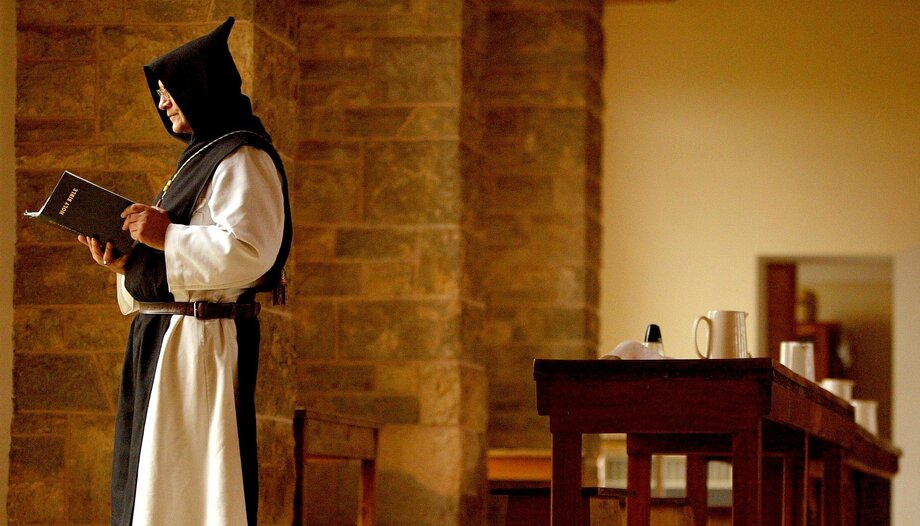 Sustainable monasteries, centuries of caring for creation
Sustainable monasteries, centuries of caring for creation One third of the world's monasteries are in Spain
One third of the world's monasteries are in SpainAlmost a thousand years ago (926), the Cistercian order was founded. Its foundation coincides with the day of the death, on March 21, 547, of St. Benedict of Nursia, founder of the Benedictine order, whose rule would later also govern the Cistercian monasteries.
The foundation of the Cistercian OrderSt. Robert of Molesmes
The exact date of the birth of St. Robert of Molesmes is unknown, although it is known that it was around 1028 in the Champagne region.
He belonged to the nobility of the region and entered a monastery of the Order of Saint Benedict very early, at the age of fifteen. Between 1068 and 1072, he was abbot of Saint Michael of Tornerre.
However, St. Robert was unhappy with many aspects of the order. He felt that it had become too rich and had too much political influence. With the intention of returning to the origins of the monastic rule of St. Benedict, he founded the Monastery of Molesmes in 1075, in the diocese of Langres. But this community was also enriched by donations. Thus, seeking a greater poverty and simplicity of life, on March 21, 1098, St. Robert founded, together with 21 companions, what was to be the first Cistercian monastery in Citeaux, a remote, rustic and solitary place. In Latin, this region was known as "Cistercium", hence the name later given to the order, "Cistercian".
However, St. Robert of Molesmes could not develop his life in the "New Monastery", as it was originally known. The monks of his previous foundation, Molesmes, asked the Pope, Urban II, to have him return. Therefore, shortly after the foundation of Citeaux, in 1099, St. Robert had to return to Molesmes, where he died in 1111.
The new monastery was entrusted to one of his disciples, St. Alberic. About a century later, in 1220, St. Robert was canonized and an anonymous monk wrote his hagiography, "Vita di Roberto".
Its history also appears in the "Exordium Magnum" or "Great Cistercian Exordium", written by a monk of Clairvaux between the twelfth and thirteenth centuries, and in the "Exordium Parvum", work of the abbot who succeeded Alberic, St. Stephen Harding, in which he indicates that "the beginning of the whole Cistercian Order, by means of a few men consecrated to the cultivation of the science of Christian life, with the wise purpose of establishing the norms of divine service and the whole ordering of its life according to the form described in the Rule, was begun with happy augury precisely on the day of the birth of him who, by the inspiration of the inspiration of the divine service and the whole ordering of its life according to the form described in the Rule, with the wise purpose of establishing the norms of divine service and the whole ordering of their life according to the form described in the Rule, began with happy augury precisely on the day of the birth of him who, by the inspiration of the Life-giving Spirit, had given the law for the salvation of many.
St. Stephen also wrote "Carta Caritatis", which is considered the rule of the Cistercian order, although it basically follows that of St. Benedict.
Flowering of the Order
The Cistercian Order flourished especially after the arrival of one of its most famous members, St. Bernard of Clairvaux, with thirty companions in 1112. According to the website of the Cistercian orderThe founders of Citeaux centered their ideals on the desire to attain authentic monastic simplicity and evangelical poverty. With the impetus of St. Bernard, new monasteries began to open one after the other, to the point that around the year 1250 the Order already had about 650 abbeys.
The first Cistercian monastery of women was founded in 1125, formed by nuns from the abbey of Jully, where St. Humbeline, the sister of St. Bernard of Clairvaux, had lived.
Operation of the monasteries
Traditionally, the monasteries structure their day around the Liturgy of the Hours: Lauds, Prime, Terce, Sext, Nona, Vespers and Compline, as well as rising in the evening for Matins. Each monastery is directed by an abbot, assisted by a prior (the "first" of the monks). Other important figures for the administration of the monastery are the treasurer, the cillero (responsible for food), sacristan, hospitaller, chantre (choir director), porter and infirmarian.
The day is lived mainly in silence, with pious readings and manual labor. The monasteries were usually founded far from the cities, and the monks took care of their own livelihood by cultivating the land and farms, a custom that is still followed in many cases.
The monk's life revolved around great simplicity in food, decoration and even liturgy. Another gesture of poverty consisted in not dyeing their habit in any color, which is why the Cistercians are known as "white monks", as opposed to the Benedictines, called "black monks" because of the color of their robes.











